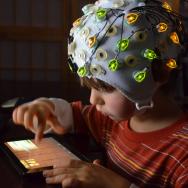Babies’ neural responses to morally charged scenarios are influenced by their parents’ attitudes toward justice, new research from the University of Chicago shows.
The study from Prof. Jean Decety and postdoctoral scholar Jason Cowell, which appears in the Proceedings of the National Academy of Sciences, sheds new light on the mechanisms underlying the development of morality in very young children.
“This work demonstrates the potential of developmental social neuroscience to provide productive, new and exciting directions for the investigation of moral development, by integrating neurobiology, behavior and the social environment,” said Decety, the Irving B. Harris Distinguished Service Professor in Psychology and Psychiatry and the College and director of the University of Chicago Child NeuroSuite.
The developmental neuroscientists found that strong individual differences in the perception of prosocial and antisocial behaviors are present in children as young as 12 to 24 months old—and that these differences are predicted by their parents’ sensitivity to justice. Moreover, parental cognitive empathy is linked to babies’ willingness to share.
“These novel and intriguing findings warrant further investigation to decipher what contributes to such early parent-child transmission of values, which may either be based on biological or socioenvironmental influences, or more likely a dynamic and complex developmental, interactional process between the two,” the authors wrote.
The 73 infants and toddlers who participated in the study watched brief animations depicting prosocial (e.g., sharing, helping) and antisocial (e.g., hitting, shoving) behavior while the authors monitored their eye movement and brain waves using electroencephalography, or EEG.
Following the animations, the developmental neuroscientists presented the babies with toys of the helping and hindering characters and observed their preferences based on reaching. The infants also played a sharing game.
Parents answered questionnaires about their children and themselves to assess their dispositional empathy and sensitivity to justice.
In the current study, all children exhibited larger brain waves in response to prosocial scenes than antisocial ones. In addition, the children were more motivated to look at “good” characters than “bad” ones, as measured by eye tracking. These findings add to a growing body of knowledge demonstrating that children are able to distinguish between prosocial and antisocial behavior from a very early age.
However, the study also suggests that by 1 or 2 years of age, some children perceive the difference between prosocial and antisocial behavior more strongly than others. Importantly, these neural differences also predicted infants’ behavior—the children who reached toward the prosocial character toy also exhibited the greatest neural differentiation between prosocial and antisocial behavior when watching the character animations.
“Precursors to morality in development as a complex interplay between neural, socioenvironmental and behavioral facets” is available online in the Proceedings of the National Academy of Sciences. The study was supported by a grant from the John Templeton Foundation.








